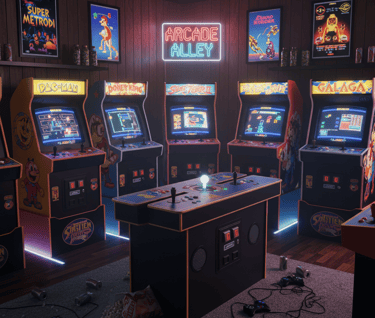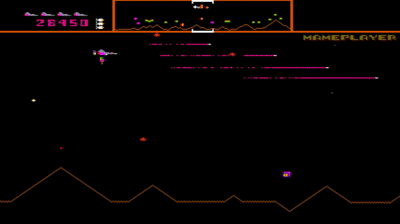Top 10 Arcade Games of all time
Cabinets that ingested more coins than all the others!


This list of the top 10 arcade games aims to capture not just individual popularity, but also their profound influence on the gaming industry and wider pop culture.
Each entry represents a significant milestone, whether it was through introducing a new genre, pioneering innovative mechanics, or creating iconic characters that transcended the arcade cabinet.
The selection prioritizes:
Impact on Gaming: How much did the game change what came after it? Did it inspire countless clones or establish a new standard?
Innovation: What unique features, technologies, or gameplay concepts did it bring to the table? Did it push the boundaries of what was possible in an arcade game?
Lasting Popularity/Cultural Significance: Beyond initial sales, how long did the game remain relevant? Does it still resonate with players today, and how deeply ingrained is it in collective memory and pop culture references?
Sales and Earnings: While not the sole factor, high earnings often reflect broad appeal and a strong market presence.
Critical Acclaim: How was the game received by critics and players at the time of its release?
Together, these criteria allow us to look beyond mere nostalgia and appreciate the games that truly shaped the golden age of arcades and continue to influence video games to this day.
10. Tempest (1981)
* Gameplay: Players control a claw-shaped ship at the edge of a three-dimensional geometric tube, shooting approaching enemies (flippers, spatters, tankers, etc.) and avoiding their projectiles.
* Popularity: Its unique vector graphics, abstract gameplay, and incredibly fast-paced action made it a visually stunning and highly addictive experience.
9. Defender (1981)
* Gameplay: Players pilot a spaceship over a scrolling, alien-infested landscape, protecting humanoids from being abducted by invaders. The game features a radar to track enemies and a limited number of "smart bombs."
* Popularity: Known for its challenging gameplay, complex controls (five buttons and a joystick), and innovative horizontally scrolling level design. It was a fast-paced and intense experience that pushed arcade hardware limits.
8. Centipede (1981)
* Gameplay: Players control a "Bug Blaster" at the bottom of the screen, shooting segments of a giant centipede as it descends through a mushroom-filled field. Other insects like spiders, fleas, and scorpions also appear.
* Popularity: Its vibrant trackball control, colorful graphics, and unique "fixed shooter" gameplay with strategic elements (shooting mushrooms to create barriers) made it a unique and popular title.
7. Ms. Pac-Man (1982)
* Gameplay: An improved version of Pac-Man, featuring new maze designs, smarter ghost AI, and moving fruit bonuses.
* Popularity: Took everything good about Pac-Man and made it better, often considered superior to the original by many fans. Its success further cemented the Pac-Man legacy.
6. Street Fighter II (1991)
* Gameplay: A one-on-one fighting game where players choose from a roster of diverse international fighters, each with unique special moves, and battle opponents in a tournament.
* Popularity: Defined the fighting game genre, introducing complex combo systems, a diverse cast of memorable characters, and incredibly competitive multiplayer. It sparked a massive arcade resurgence.
5. Galaga (1981)
* Gameplay: A fixed shooter where players control a starfighter, battling waves of alien insects. A key feature is the "tractor beam" maneuver, where an enemy can capture the player's ship, and the player can then rescue it to gain a powerful "dual fighter."
* Popularity: Built upon the success of Space Invaders with improved graphics, more varied enemy patterns, and the innovative dual fighter mechanic, making it incredibly replayable and challenging.
4. Asteroids (1979)
* Gameplay: Players control a triangular spaceship in an asteroid field, shooting and destroying incoming asteroids and occasional enemy flying saucers. Larger asteroids break into smaller, faster pieces.
* Popularity: Its vector graphics were visually striking, and its innovative "wrap-around" screen mechanic and tense, strategic gameplay made it incredibly popular and influential.
3. Space Invaders (1978)
* Gameplay: Players control a laser cannon at the bottom of the screen, moving horizontally to shoot down waves of descending alien invaders. The aliens gradually speed up and move closer as their numbers dwindle.
* Popularity: Revolutionized the gaming industry and caused a nationwide coin shortage in Japan. Its simple, challenging "shoot 'em up" gameplay was instantly engaging and laid the groundwork for countless future games.
2. Donkey Kong (1981)
* Gameplay: Players control Jumpman (later known as Mario) as he attempts to rescue a damsel in distress (Pauline) from a giant ape, Donkey Kong. The game involves climbing ladders, jumping over barrels and other obstacles, and using hammers to destroy them.
* Popularity: Introduced platforming gameplay, a multi-stage level design, and two incredibly famous characters (Mario and Donkey Kong) who would go on to star in countless other games.
1. Pac-Man (1980)
* Gameplay: Players control Pac-Man, a yellow, circular character, through a maze, eating dots and avoiding four colored ghosts. Power pellets temporarily turn the ghosts blue, allowing Pac-Man to eat them for bonus points.
* Popularity: Its simple yet addictive gameplay, iconic character, and unique premise (eating vs. shooting) made it a cultural phenomenon. It appealed to a broad audience, including women, which was rare for arcade games at the time.




















